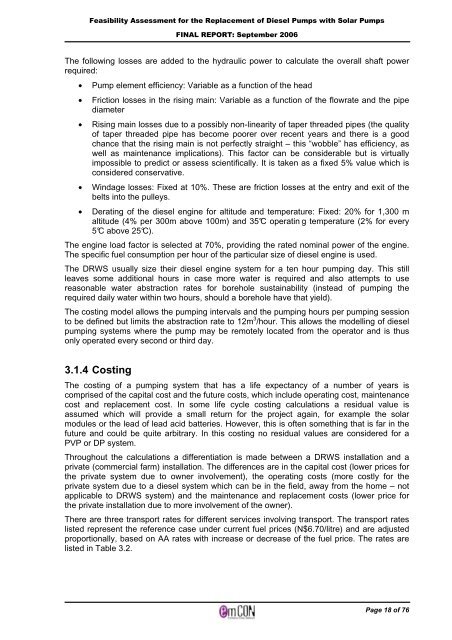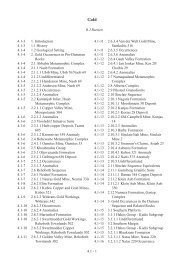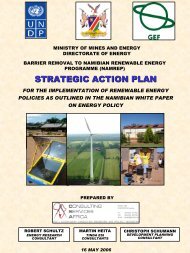Solar PV water pumping study - FINAL REPORT ... - UNDP, Namibia
Solar PV water pumping study - FINAL REPORT ... - UNDP, Namibia
Solar PV water pumping study - FINAL REPORT ... - UNDP, Namibia
Create successful ePaper yourself
Turn your PDF publications into a flip-book with our unique Google optimized e-Paper software.
Feasibility Assessment for the Replacement of Diesel Pumps with <strong>Solar</strong> Pumps<br />
<strong>FINAL</strong> <strong>REPORT</strong>: September 2006<br />
The following losses are added to the hydraulic power to calculate the overall shaft power<br />
required:<br />
• Pump element efficiency: Variable as a function of the head<br />
• Friction losses in the rising main: Variable as a function of the flowrate and the pipe<br />
diameter<br />
• Rising main losses due to a possibly non-linearity of taper threaded pipes (the quality<br />
of taper threaded pipe has become poorer over recent years and there is a good<br />
chance that the rising main is not perfectly straight – this “wobble” has efficiency, as<br />
well as maintenance implications). This factor can be considerable but is virtually<br />
impossible to predict or assess scientifically. It is taken as a fixed 5% value which is<br />
considered conservative.<br />
• Windage losses: Fixed at 10%. These are friction losses at the entry and exit of the<br />
belts into the pulleys.<br />
• Derating of the diesel engine for altitude and temperature: Fixed: 20% for 1,300 m<br />
altitude (4% per 300m above 100m) and 35°C operatin g temperature (2% for every<br />
5°C above 25°C).<br />
The engine load factor is selected at 70%, providing the rated nominal power of the engine.<br />
The specific fuel consumption per hour of the particular size of diesel engine is used.<br />
The DRWS usually size their diesel engine system for a ten hour <strong>pumping</strong> day. This still<br />
leaves some additional hours in case more <strong>water</strong> is required and also attempts to use<br />
reasonable <strong>water</strong> abstraction rates for borehole sustainability (instead of <strong>pumping</strong> the<br />
required daily <strong>water</strong> within two hours, should a borehole have that yield).<br />
The costing model allows the <strong>pumping</strong> intervals and the <strong>pumping</strong> hours per <strong>pumping</strong> session<br />
to be defined but limits the abstraction rate to 12m 3 /hour. This allows the modelling of diesel<br />
<strong>pumping</strong> systems where the pump may be remotely located from the operator and is thus<br />
only operated every second or third day.<br />
3.1.4 Costing<br />
The costing of a <strong>pumping</strong> system that has a life expectancy of a number of years is<br />
comprised of the capital cost and the future costs, which include operating cost, maintenance<br />
cost and replacement cost. In some life cycle costing calculations a residual value is<br />
assumed which will provide a small return for the project again, for example the solar<br />
modules or the lead of lead acid batteries. However, this is often something that is far in the<br />
future and could be quite arbitrary. In this costing no residual values are considered for a<br />
<strong>PV</strong>P or DP system.<br />
Throughout the calculations a differentiation is made between a DRWS installation and a<br />
private (commercial farm) installation. The differences are in the capital cost (lower prices for<br />
the private system due to owner involvement), the operating costs (more costly for the<br />
private system due to a diesel system which can be in the field, away from the home – not<br />
applicable to DRWS system) and the maintenance and replacement costs (lower price for<br />
the private installation due to more involvement of the owner).<br />
There are three transport rates for different services involving transport. The transport rates<br />
listed represent the reference case under current fuel prices (N$6.70/litre) and are adjusted<br />
proportionally, based on AA rates with increase or decrease of the fuel price. The rates are<br />
listed in Table 3.2.<br />
Page 18 of 76




